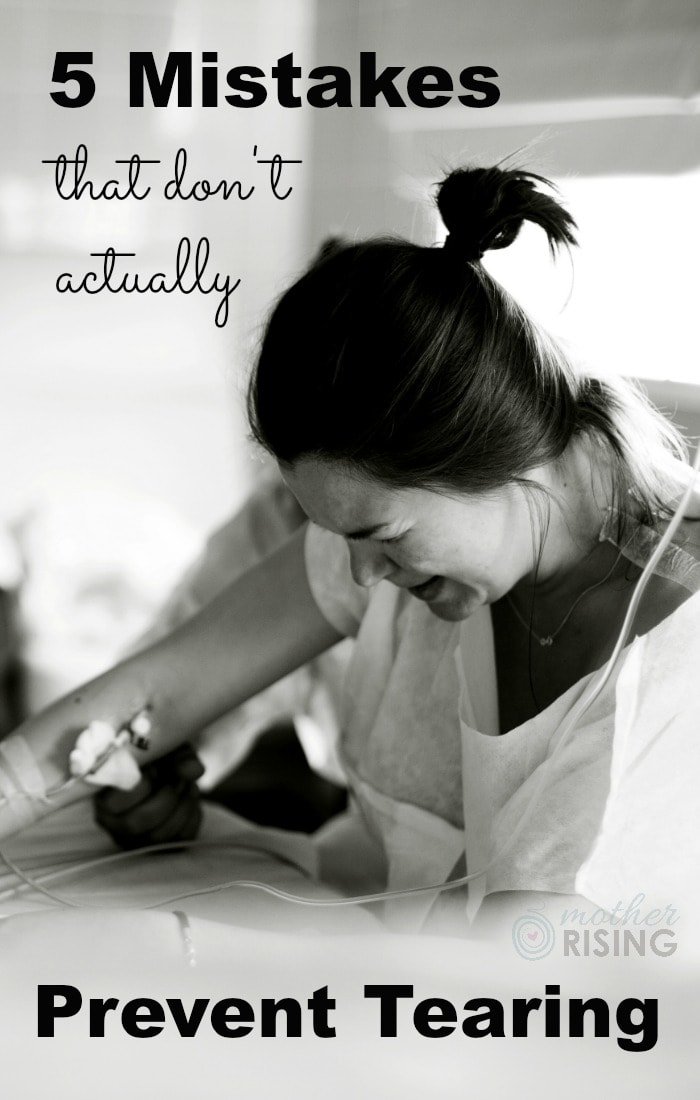Preventing tearing during birth requires a group effort. There are helpful things a woman can do, and there are helpful things a care provider can do, too. However, there are also some mistakes in childbirth that harm vulvas that both parents and care providers make.
5 Mistakes in Childbirth That Harm Vulvas
The following are five of the most common mistakes in childbirth that harm vulvas, and easy ways to fix each of them.

1. Believe Everything
There is a lot of “interesting” information floating around in regards to tearing during birth. For example, during a recent pedicure my nail technician, once she found out what I do for a living, shared part of someone’s birth story (as they always do 😉 ). At the end of the story, however, she said something that surprised me.
“My sister was really young when she had her first baby so, of course, she tore.”
I’ve also heard shocking statements from obstetricians regarding tearing.
“Indian women are just smaller and more likely to tear.”
“The average first time mom has a second degree tear.”
One of the first mistakes women make when preparing to give birth and learning how to prevent tearing is to believe everything they’ve heard, from others, from shows and movies, and even themselves.
What beliefs do you have about tearing during birth? What have you heard? Where do these beliefs come from? Are they true? Spend time answering these questions and notice what comes up. Dig around to explore unfamiliar ideas and possibly shift the paradigm.
A great place to start is Ina May’s Guide to Childbirth. Not only does Ina May help the reader to see another perspective in regards to tearing, but the included birth stories are so encouraging. I highly recommend it!

2. Push in the “Usual Position”
I was recently at a birth and towards the end things were happening VERY FAST. My client had been rocking transition and all of the sudden, she felt the urge to push and baby was coming NOW. Care providers were scrambling, and just in case a random doctor even showed up!
Thankfully, her OB arrived in the nick of time, thus preventing a stranger or dad from catching baby! Always a good thing. 😉
After he arrived, however, the first thing her OB did was to prepare the hospital bed to assist my client into the lithotomy position. He got one stirrup setup, which immediately prompted a conversation between my client and I.
After a brief discussion, she told me she wanted to stay in the position she was in. I relayed this to her care provider, which was followed by brief silence, and then a reply of, “ok”. Minutes later (literally), she pushed her baby out, in the position she chose, and I am happy to report she did not tear.
Unless otherwise directed, many obstetricians default to a semi-reclined lithotomy position. This is a great position to be in… for the care provider. But not so much for mom.
You see, birthing positions that take pressure off the sacrum like kneeling, standing, all‐fours, side-lying, and on a birth seat, may help prevent tearing during birth. (SOURCE)
Do some research, find out what birthing positions sound appealing to you, and discuss this with your care provider at your next appointment.

3. Use Perineal Massage
Perineal massage is when the perineum is pre-stretched during the pushing stage, right before crowning. With lubricating jelly, a care provider places two fingers in the vagina, and pushes down and to the side, over and over again.
Ironically, this practice actually swells the skin and tissues, making a woman more likely to tear. Perineal massage during pushing doesn’t work and needs to stop.
NOTE: Perineal massage, when done during pregnancy, has been shown to reduce the risk of an episiotomy with first time moms. (SOURCE) However, in my experience, this risk is drastically reduced by choosing the right care provider. Have a talk with your care provider and ask them about their episiotomy rates.
Alternative: Warm Compresses
A wonderful compromise to perineal massage is warm compresses. The warmth of a compress, coupled with firm support to the perineum, has been shown to decrease tearing. (SOURCE)
To start, have your nurse, doctor, or midwife gather a small basin or crockpot, and a stack of 5 washcloths.
- Fill the basin with very warm water.
- Place the washcloth in the water, and wring it out.
- If the washcloth is too hot for your fingers, it’s too hot for mom. Wait until it cools some.
- With firm pressure, place your hands and washcloth on mom’s perineum while baby crowns.
TIP: Many midwives I know use ginger with warm compresses to further reduce inflammation.
NOTE: Because the Instant Pot has become so popular, you can now find lots of crockpots at thrift stores for cheap.

4. Push Too Hard
Another mistake that doesn’t actually prevent tearing happens when women push too hard; especially when baby is crowning.
If a woman is pushing in a way that is forceful and unnatural, odds are she is being coached to push. The alternative is to allow a woman to push spontaneously and undirected. For a woman that is unmedicated, it’s best to be hands off physically, and to allow her body to push in its own time. (SOURCE)
Coached or forced pushing may sound like:
- A nurse instructing a woman to hold her breath while counting to ten, two to three times during each pushing contraction.
- A doctor or midwife telling a woman to push after baby’s head is out, but between contractions, when she has no urge to push. (You can read more about this phenomenon here.)
Alternative: Push with Great Strength, Slowly and Gently
Instead, it’s best to push instinctively with great strength, slowly and gently. Before baby is crowning, it may be helpful to envision pushing with the strength of a gorilla. However, when baby is crowning, pushing slowly and gently is a great way to prevent tearing.
Listen to your care provider as they guide you through these intense moments of birth. You may want to push like a wild woman to “get the baby out”, but anything you can do to allow things to unfold slowly will help prevent tearing.

5. Use the Wrong Care Provider
Last weekend, at the end of the hospital childbirth class I taught, a woman came up to me to ask me my opinion about which hospital would be best for a natural birth in the city where we live. Oh boy.
After stating a brief unbiased list of pros and cons about each facility, I told her what I thought what was most important. I said that if I had to pick between a state of the art birthing suite with a terrible care provider and a rinky-dink hospital room with an amazing care provider I trusted with my life, I would choose the latter.
I told her that who you choose as your care provider will influence your birth more than you know, and that you will remember and think about your birth for the rest of your life. Birth matters.
I’ve heard stories of an OB in my town that has used a vacuum and/or performed an episiotomy to hasten delivery, solely so to get to another birth at a different hospital. Unfortunately, because of their bait and switch tactics, it seems to be difficult for their patients to determine what they’re dealing with util it is seemingly too late.
How can parents know when it’s time to fire an OB or midwife? Glad you asked. Parents, pay attention! Here are 15 tell-tale signs that it’s time to fire your OB, midwife, or other care provider.

5 Mistakes in Childbirth That Harm Vulvas
Mother Rising’s vision is to educate, encourage, and empower women on their journey to motherhood through compassionate, vulnerable, and authentic teaching. Ladies, I want you to have an amazing pregnancy, childbirth, and transition to motherhood. and preventing tearing is a piece of that puzzle.
Just to recap, the following are 5 mistakes that harm vulvas.
- Believe Everything
- Push in the “Usual Position”
- Use Perineal Massage
- Push Too Hard
- Use the Wrong Care Provider
Leave a Comment
What do you wish you had done differently in regards to tearing? What do you know now that you didn’t know before? Leave a comment and let’s chat.


Ana
Sunday 10th of November 2019
Wow! I love this article! I always feel like I read these things too late. I delivered both my babies naturally, but BOTH TIMES my care providers forced me into the “usual position”.
I actually spent both labors on my feet because that’s where I was comfortable. I wanted to deliver squatting, because lying down was immensely painful. But who is able to have a discussion when you are 10cm dilated with contractions rolling over each other like waves during a storm?
Ah well... I loved this article. Maybe you could share what happens if you DO tear, and what your options are. (I tore only a little with my first, and the recovery from the 2 stitches was.... not ideal :( I’m still mad about it.)
Ruth
Sunday 3rd of November 2019
I’m a birth doula, and my mom has had 14 babies. The only one she ever tore with was her first. She will tell you to this day that she thinks she wouldn’t have torn if she’d had a different care provider. She’s had 5 home births, and at each of those used the warm ginger compress. I have only been to one hospital birth that a mom didn’t tear at(other than my own mother’s)And it’s near impossible to get the Drs. At the military hosptials(where I usually work) to listen to mom and work with her desired pushing position. It’s so frustrating .
Corrie
Thursday 31st of October 2019
Man I wish I could hire you for my next one! My first was (what I feel like is the norm here) cold, unsupportive, and coached. I had a second degree tear after several hours of coached pushing and forceps.
Lindsey VanAlstyne
Thursday 31st of October 2019
:( I'm sorry. You and all women deserve better.
Em
Thursday 31st of October 2019
I absolutely loved my midwife but was surprised at a few things. Looking back, my water broke in the tub and it was full of meconium. I was told I had to get out. I am not sure if that is true but I listened. They helped me onto the bed in the "usual position". I was so incredibly uncomfortable. My doula later told me they touched me the whole time. Lots of perineal massage and touching.
All of these things were clearly stated as things I did not want in our birth plan but when it came to show time I was in birth land and just listened. I am 6 months pregnant with my second baby and have chosen a home birth with a midwife. I have been very vocal with my husband, doula and midwife about these things and asked that they advocate for me if I am unable to. I think I will be more aware this go around with some of the things I feel strongly about. I am believing for a better experience all around.
On a different note: I bled after giving birth a ton and had to have pitocin. Again, I was later told by my doula there was a lot of tugging on my placenta and then I started to bleed. I am choosing this time to have my placenta born naturally and a hands free birth for both baby and placenta.
Thanks for reading. Any advice from you is dearly welcome.
Lindsey VanAlstyne
Thursday 31st of October 2019
Hey Em, thanks for sharing your story. I'm so sorry you weren't encouraged to follow your natural instincts with your first birth. I wish you all the best with your second. It sounds like you're listening to your instincts and you've found your voice. I'm so proud of you!